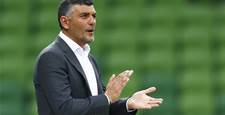Australia is not blessed with a glut of highly creative No.10s coming through and we have to change our training methods at a youth level to remedy this.
Potential playmakers need to be encouraged to operate in that position with freedom, as in the past in Australia such players have simply been labelled as lazy. We have to get away from this mentality at all levels
of the game.
It should not be a case of Australian players having to go overseas to learn such skills, we should be nurturing them in this country. We have to look at the way we structure our youth competitions, including the pressure coaches are under to get results.
When you have promotion and relegation in competitions for young kids, that is ridiculous. As coaches need instant results, they look for the bigger and quicker kids, rather than the more skilful players who should be nurtured.
Many young playmakers are left by the wayside as coaches look for wins. It's wrong and I don't understand it.
Promotion and relegation at youth level is designed to create more competition, but that aspect is already there when the kids play each other.
With the next generation of Australian players coming through, we have to give them the freedom to express themselves on the pitch and not suffocate their talents with overtly results-orientated competitions.
If the kids are more worried about losing the ball, which could lead to conceding a goal and the team getting relegated, then they won't try everything they are capable of.
Budding playmakers still need to understand their role when the team doesn't have possession, which remains important, but the reason such players are in the team is to
open-up defences and create goal scoring opportunities.
It is about laying down some responsibilities in a defensive structure while compensating for the playmaker with other players who do their share of defending. The defensive players have to be mindful that a playmaker may try things that are unsuccessful, lose possession and they have to defend with that in mind.
The playmaker role is also more than just what you can do with the ball. As well as having to defend, much of their work takes place without the ball, reading the game and positioning themselves so they can receive the ball in space and orchestrate play.
In the past, the traditional No.10 sat
in the middle of the pitch, but with the midfield being packed with bodies in
the modern game, playmakers now increasingly have to drift out wide in order to find the space to operate.
Most people go to football games to watch playmakers and similar players too, so we need to ensure these players have the freedom to entertain.
We don't have enough technical players because the coaches in Australia have not worked with them enough on this technical approach as they progress through the age groups.
I do not think it is a case that potential playmakers have their natural tendencies coached out of them in Australia, it is more that such an approach has never been coached into them in the first place.
There are a couple of different models we can introduce, but it boils down to ensuring players have as many touches on the ball as possible.
Playmakers are something we're clearly lacking in the Socceroos too. Tim Cahill's game is more around running and arriving late in the box, while Brett Holman is someone who looks to make runs beyond the opposition's back four.
We have to encourage more flair play and nurture those types of players. It all comes back to what we are trying to develop right now in Australia with the introduction of the skill acquisition coaches. It is important that they are used to indentify the players who have the best technical ability.
I had a couple of playmakers at the Jets in Nicky Carle and James Holland, and Nicky was by far the best option I had in that number 10 role.
However, Nicky still liked to drop deep to pick the ball up and I really wanted him to do his work in that final third, but he had such an engine on him that he wanted to track back to pick up the ball and start attacks from his own half. We needed someone to start that attack and give the ball to Nicky further up the pitch, where Nicky could do more damage.
It is only from giving young players more freedom to express themselves that Australia will start to produce the type of magical playmakers that we all love watching from other nations.
Managerial masterclass - Utilising your playmaker
Playmakers have an interesting role within your team and a lot depends on how you're using them within the team. You need to decide if you are playing them as a midfielder alongside a more defensive player or as a second striker with a more offensive number nine.
Playmakers have to understand when they're playing as a striker or if they have midfield duties too. If they are given too much of a free role, then the balance of the team can be put out. Most teams play with a 4-3-3 and the playmaker can either support the stiker in the centre or move out wide to create chances from there. If you have a playmaker who likes to take on players then a wider role is a better, and safer, idea. The reasoning is if you lose the ball in a wider area, it is easier to contain the turnover in possession from a defensive perspective. Two good examples of playmakers who do their best work in wide areas are Ronaldinho and Arjen Robben.
If you have more of a ball-playing playmaker in your team, then try to use them centrally in behind one or two strikers, where they can produce killer balls, provide assists and score goals."











